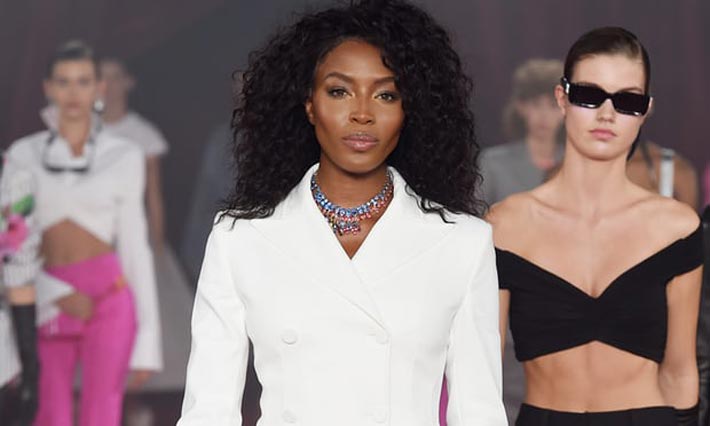When she’s not storming the catwalk, or lunching with former first ladies, Naomi Campbell has a front row seat at major shows, and a place on the masthead of fashion bible Vogue

The year 1990 was a good one for Naomi Campbell. That January opened with a spot on that supermodel cover of British Vogue, alongside Cindy, Christy and Linda. After that came the covers of French and Italian Vogue, as well as posing for Peter Lindbergh in a convertible full of dalmatians in a classic Grace Coddington shoot for American Vogue (that still turns up on moodboards to this day), walking for Gianni Versace in Milan and lip-syncing for George Michael’s Freedom ‘90 video. Not bad.
Now 2017 looks to be an equally good year for Campbell, now aged 47, a career arc that defies the norms of modelling. This is the age of the Naomissance.
Campbell’s profile in the fashion industry is higher right now than it has been since she ruled the catwalk two decades ago. As newly installed contributing editor of British Vogue, Campbell took an unmistakably powerful seat in the front row of the Burberry show at London fashion week, between editor-in-chief Edward Enninful and Kate Moss, who is also on the Vogue masthead. At Paris fashion week, Campbell was snapped emerging from lunch at the Ritz with fellow supermodel and former French first lady Carla Bruni. And on the Friday night of Milan fashion week she almost broke the internet in her metal-mesh Versace gown, as the central figure in the five-strong lineup of supermodels who joined Donatella for a catwalk tribute to her late brother.
It is quite the turnaround for brand Naomi, which not so long ago spent the best part of a decade under the shadow of four convictions for assault. Then there was the tawdry business of the blood diamonds, an unedifying tale of “dirty-looking stones” being handed over late at night, and an eventual court appearance at Charles Taylor’s war crimes trial. None of this was helped by Campbell’s tin ear for the handling of these episodes. She wore a silver Dolce & Gabbana gown for community service in New York (“what do they expect me to do – Walk in looking all drib and drab?”) and initially declined her subpoena from The Hague, declaring it a “big inconvenience”.
Witless statements like that one served to muffle the smart points Campbell has been making about the fashion industry for a long time. The model may be tone deaf to coming across as a spoilt brat, but many senior figures in the industry have a more damaging lack of sensitivity.
Karl Lagerfeld calling the young Naomi Campbell “a black Brigitte Bardot” is just one off-colour example, and Campbell has been calling out racism, prejudice and double-standards for two decades. As far back as 1997, Campbell told an interviewer that “there is prejudice. It is a problem and I can’t go along any more with brushing it under the carpet.” The same year, she railed against the “narrow-mindedness” of a newsstand culture in which “this business is about selling, and blond and blue-eyed girls are what sells”. A decade later, she criticised mainstream model agencies for ignoring or not promoting non-white models. In 2013, she joined with Bethann Hardison and Iman to found a “Diversity Coalition”, calling out those designers who “consistently use one or no models of colour” in their shows. “No matter their intention, the result is racism,” stated an open letter.
In 2017, it has become fashionable to make the points about diversity that Campbell has been putting forward for two decades. Edward Enninful, whose first issue of Vogue as editor is out in a fortnight, has already had a notably diversifying impact on the masthead, installing film-maker Steve McQueen and makeup artist Pat McGrath on the team. Campbell, never one to pull a punch, posted on Instagram a team photo from the outgoing editor Alexandra Shulman’s farewell issue, highlighting the all-white lineup. In the fashion industry, progress is being made. Casting directors and designers have finally woken up to it not being OK to exclude a skin colour because it doesn’t fit with their vision for the season. (And yes, that was totally a thing.) A study by thefashionspot.com highlighted an improvement in the proportion of non-white models used in fashion advertising campaigns, which has almost doubled from 15.3% in autumn 2015 campaigns to 30.4% in 2017.
But this is fashion, and you have to be cool as well as clever. Luckily, Campbell’s cultural capital is riding high on a wave of 90s revivalism which has trickled down from hipster to high street this year. Luckily, too, she has entered her late 40s at a time when the industry has relaxed longstanding rules in which women were essentially banished from view at 35. And as her luck would have it, if there’s one thing 21st-century popular culture loves more than a hot young thing, it’s a retro-tinged comeback. We had the McConnaissance. We have seen the second coming of Nicole Kidman. Now, nearly three decades after she was first on the cover, Campbell is closer to the power seat at Vogue than she has ever been.
Source: theguardian.com
